A GPS is nice, however it can make you lazy about finding your way around the city. In a time of crisis that can easily be your undoing because you will not have a viable means to find your way out of the city as quickly and efficiently as possible.
So you’ll come to the conclusion that you are as helpless as a baby in the woods unless you know how to use maps and apply natural navigation methods to the city environment.
That’s why you must have already developed and tested your escape plans for leaving the city before any crisis occurs. The plan should be developed and tested for traveling above ground as well as traveling underground.
To be prepared and ready for a major crisis you must make up two bug out bag kits. The first one to be carried in your brief or back pack that would get you safely home and or out of the city. The second one that would be kept at home and would have more detailed information on all routes out of the city to a place of safety.
Each Bug Out Bag should contain at least the following items.
- Maps, schematic of underground conduits, and directions for the trip that include above and underground travel with alternate routes. (Note – the maps and schematics in your bug out kit at home would contain maps of the entire city as opposed to simple routes to get home. Depending on where you are located in the city, you may need an extensive library of maps, hence the reason for storing them at home instead of trying to keep them all with you.)
- Compass for finding the heading.
- A spare watch to tell time with, preferably a wind up watch that does not rely on any type of integrated circuit.
- Paper, pens, and pencils to write with.
- Energy bars, dried trail mix, candy bars and bottled water to drink.
- A good utility pocket knife or a survival sheath knife.
- A coil of para cord about 50 feet long.
- Small compact flashlight with extra batteries.
- Fire starting kits to start fires when needed.
There are two basic ways to travel in a time of social unrest. The first way would be above ground in daylight or darkness. The second way is underground in daylight or darkness.
There are two main types of city street layouts. The grid and the organic layouts.
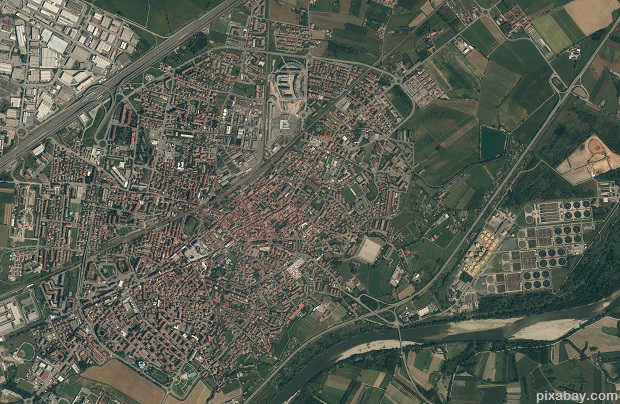
In the US, the grid system was widely used in most major cities and suburbs until the late 1960s. The grid layouts like New York City are pretty easy to navigate because all roads are built in one or two directions. In the grid layout, streets run at right angles of each other.
There are two basic ways of naming these roads. Normally avenues run north and south and streets run east and west. One of the main advantages of a grid layout was it allowed the rapid subdivision and auction of a large parcel of land.
The organic road layouts occur when roads are built as the city needs them rather than with a long term structured plan. An organic city is one that grows over time from old designs focused around things that were relevant at the time.
This might include an original settlement, a resource, important community landmark, or something else. In some cities current roadways follow historical roads that trace long forgotten land borders or old traveling trails.
Seven Ways To Find Your Way in a City
Satellite Dishes
Look for satellite dishes on buildings or towers. Satellite dishes work by pointing the dish towards a geostationary satellite that stays over the same point. Because of this, most dishes in the city will be pointing in the same direction.
Compare many dishes that are pointing in the same direction and this will give you the best idea of the true direction the dishes are pointing to. Compare the satellite dish direction to compass readings in order to determine what direction they are pointing in and how that relates to the North. At night, you can also compare dish directions to constellations with known orientations in relation to the Earth.
Religious Buildings
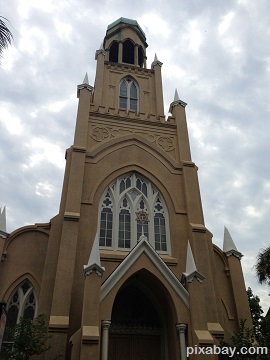 In the larger older cities most churches were built to face east and can be used to get a rough estimate of which direction you are pointing. Sometimes this is not very accurate, but it can get you started until you find a better way in which to use as a navigation aid.
In the larger older cities most churches were built to face east and can be used to get a rough estimate of which direction you are pointing. Sometimes this is not very accurate, but it can get you started until you find a better way in which to use as a navigation aid.
Christian churches are normally aligned east to west with the main alter at the eastern end to face the sunrise. In addition, many church grave yards have their gravestones aligned east to west.
To find the direction from a mosque, go inside and look for the prayer niche in one of the walls which indicates the direction for prayers. If the mosque is west of Mecca, then this niche will be pointing east. If the Mosque is east of Mecca, then the niche is pointing west.
Synagogues normally place the Torah Ark at the eastern end of the building. It is positioned this way so worshipers face Jerusalem. Synagogues in countries east of Israel will place the Torah Ark in the western end of the building to face Jerusalem.
Weathering
The prevailing winds carry rain and pollutants. These two substances then hit the building leaving patterns of discolorations on the buildings. If the wind comes from one direction more than the others, say the southwest, this leaves asymmetrical weathering patterns on buildings similar to the erosion observed in nature.
Look up at the higher floors to see the natural stone or the weathered bricks. Notice how the building corners all show different weathering patterns. The contrast between the southwest and the northeast corners would be the greatest. With a little practice the shifts in colors where the rain and pollutants have left their mark can be read on all sides of the buildings.
Flow of Pedestrians
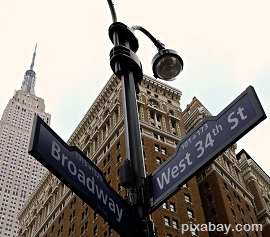 If you are trying to get from one point to another study the flow of pedestrian traffic. By following a crowd in the late afternoon, it will take you towards a station or other transportation hub. In the morning, walk against the flow of the crowd to locate these stations. At lunchtime on a nice sunny day, the crowds move from office buildings towards the open areas of parks.
If you are trying to get from one point to another study the flow of pedestrian traffic. By following a crowd in the late afternoon, it will take you towards a station or other transportation hub. In the morning, walk against the flow of the crowd to locate these stations. At lunchtime on a nice sunny day, the crowds move from office buildings towards the open areas of parks.
Very few people realize when they are lost in a large city that roads do not spring up randomly. They grow to carry traffic. The bulk of the traffic is either heading into or out of the city. The biggest roads tend to be aligned in a particular way depending if you are in the center or the outskirts of the city.
In the north or south of a city the major roads will tend to be aligned north or south. In the northwest or southeast of a city there will be a bias towards northwest or southeast. This is why road maps of big cities show a radial pattern.
Flow of Rivers in the City
Know the direction a river flows through your city. Does it flow north, south, east, or west? Is the flow from higher ground to lower ground? Do these rivers flow to the sea or to other rivers?
After you find the answers, it makes it easier to decide if leaving the city by water is a feasible plan. If it is not then you must adjust your plans and use other means.
Direction of Bridges
Know which direction bridges go. Before a time of crisis your travel plans must be completed and you must decide if the use of bridges would help you to leave the city or would they put you at risk. In the early part of a crisis before road blocks are set up, they may be useful. After the road blocks are in place it could be almost impossible to get safely across them due to riots or others that will block your path.
The Use of Clouds Blowing Across the Sky
To keep from getting lost in a city, you need to develop a good sense of direction. You must orientate yourself to the city. To do this is to use some of the clues above. Then note the direction the clouds are moving. The wind pushing the clouds will remain fairly constant, providing there are no dramatic weather changes.
This technique works when on subway trips in a new part of the city. Simply look up before entering the subway and remember the direction the clouds were blowing. When you leave the subway in a strange part of the city look up again and you will be able to work out which way is which from the clouds over head.
One of the nice things about traveling in a city is that at every intersection there are elevated road signs on poles to show the average person the name of the road, The block number, and the direction of the road is going. An example of this is: 105 A ST. West.
This address is in the 100 block of A Street West building number 5. In most big cities when there is a long street that has been separated into East and West. There is a boundary crossroad that is the neutral. All street addresses that are East of this road will have the East locator added to the address. The same is true with the West portion of the street.
In a time before a crisis it is to your advantage to know how to travel around a city both on the surface and underground without the aid of a GPS or a smart phone. During a crisis the odds are all electronic navigation systems will be down or be greatly reduced to the general public.
Using the older navigation methods will be the only way to travel around a new part of the city. If you have done your homework and practiced the odds are very good that you will each your destination safely.
Interested in surviving blackouts? CLICK HERE to find out more!
This article has been written by Fred Tyrell for Survivopedia.


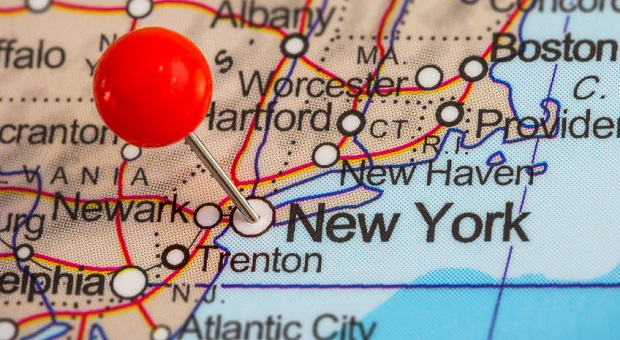




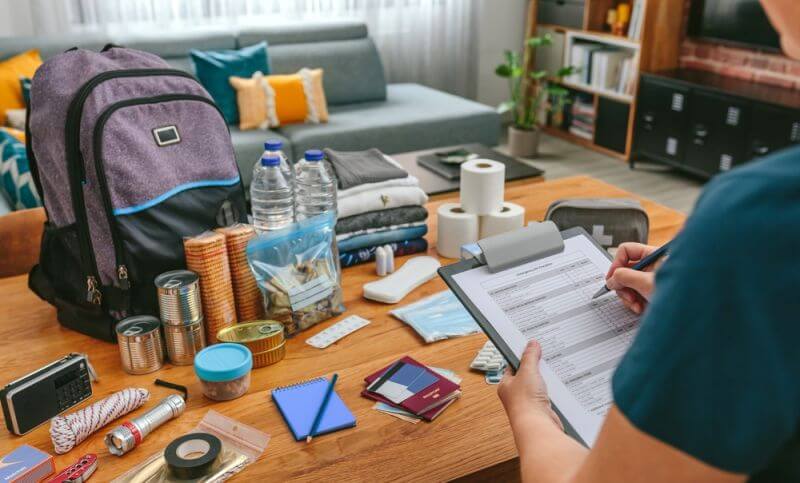

Pingback:Lost In The City? 7 Ways To Navigate Without GPS - Survivalot | September 24, 2015
|
Pingback:Lost In The City? 7 Ways To Navigate Without GPS | TheSurvivalPlaceBlog | September 24, 2015
|
Elizabeth Jones | September 24, 2015
|
I appreciate this information. I strongly suggested on a recent Post on my Website that moving from a high rise apartment building in a big city would be one of the smartest things one could do. Of course, if one has to work inside a large city this information would be a must. I will share the list of necessary items on my site.
Thanks
don | September 24, 2015
|
Some areas have large easements for utilities such as power lines and gas pipelines that are grassy and maintained for inspection purposes. The often go for miles.
Richard | September 24, 2015
|
I do appreciate you sending out this information but people in the inner cores will not survive a collapse .It’s that simple and that drastic. I hope my story will help people understand.Forty years ago I was self employed.Being so it behooved me to pay attention to government affairs,laws and ordinances. I watched as our constitution was being cut up and our freedoms erode. Thirty years ago I decided that the U.S. was not for me.It was headed in the wrong direction so I started studying other countries,economies,laws,climates,real estate prices and so on.
Fifteen years ago I visited Costa Rica to take a look around and meet the people. No place is perfect but I liked what I seen. All those years I studied homesteading/survival skills. Costa Rica is not a modern country which is exactly what I was looking for. Homesteading means starting over,learning new skills and living closer to the earth.Twelve years ago I retired to C.R. and bought a farm at 3000 ft. elevation with three year round springs on it. I have never been so free.I have created my paradise from study and working my plans of self sufficiency.People will say “Ya but”. The are no, Ya buts,we all have choices,we make them everyday.If you see things are wrong,that you are getting nowhere running as fast as you can,that something has to change and you are the only one that can change your life. This plan of mine lasted for thirty years and is still going on today.My life is my life.I do not belong to any country or corporation,I am no longer slave labor.I don’t have government agencies breathing down my neck telling me what I can and cannot do. I hope you all understand this and feel the same way I do.
Mahatma Muhjesbude | September 25, 2015
|
Richard, I’ve been to Costa Rica some years ago to help out an ‘ExPat’ friend of mine who got into some ‘trouble’. I’ve also owned land in Belize. In C.R. Can you legally own any firearm without the authorities knowing about it or being able to seize them at the first sign of political unrest? Are the police allowed to trespass and search your property without a warrant?
Richard | September 25, 2015
|
People have a normalcy bias. They seem to feel things will be the same after a collapse.One of them is the intrusion of governments and law enforcement after the collapse. The rules will change.Warrants will mean nothing,even police protection will be nonexistent.Remember,the police are humans as well and will be fighting to exist as well. Whether you own a gun or not has nothing to do with permits or right to own or law and order.It’s gone.
Bueno suerte.
Mahatma Muhjesbude | September 25, 2015
|
Richard, what you just said is obviously true and ‘expected’ AFTER a collapse. But that’s not what I asked you. Is Costa Rica, or virutally anywhere in South America a country that gives its citizens a 2nd/A and 4th/A style unquestioned Liberty protections, lIKE THE U.S.A. DOES..
…BEFORE any big collapse? A NOT so subtle, and important distinction for future survival. One I’ll gladly explain for you if you give me an honest answer to my original question?
Richard | September 25, 2015
|
Okay Amigo. In Costa Rica you can obtain a carry permit.It is time consuming and expensive. Often times you can use the reason for self protection is good enough.
The fact is that it is hard to find a Tico that does not own a one gun or more without permits. It is a recorded fact that Ticos hate governments.
A Tico friend of mine bought a black hand gun from a policeman. That should give you an idea of gun laws in C.R.
Mahatma Muhjesbude | September 25, 2015
|
Okay, Rich, at least now I know what your occupation is by your obstinate non-answer. Politician, Lol.
I don’t want an ‘Idea’ of black market gun rights laws, We already have so much of black market access weapons here that it make your area look the TSA security at Chicago O’hare.
Since you won’t answer my question concerning the point about you ‘never being so free’ living in Costa Rica, if you’ve been reading my essays, you know I am a very serious analytic critic of anti-Liberty venues and inveterate supporter of individual rights and ABSOLUTE Freedom. So I will answer the question for you when I get time–maybe this weekend–because I have to go to class now and try to make the skulls full of mush absorb some reality history about their good fortune to live in America in opposition to what the leftists and theocrats have historically interpolated, redacted, and specifically lied about in their agenda based education venues.
But stay tuned, I have a couple other q’s for you because I always like to get my ‘intel’ directly from first hand ‘boots on the ground’ if possible. Not from marketing hearsay or biased subjectivity. Thanks.
Richard | September 25, 2015
|
Senior Mahatma. First,I am paranoid,I admit it.I do not like giving out too much information to people I don’t know.Thanks for filling me in.
You are invited to ask me questions about Costa Rica,farm life,survival actions such as water supply,crop selections,animals or not,purposes for using the sun and so on.Also to know the culture of the Ticos. One reason I chose C.R. is because they have survived for four hundred years without outside imperialism.I wanted to know how they did it.C.R. is not a modern country but that is exactly what I wanted to move to.In a economic down turn ,I always believed that people that lived closer to the earth fared better.Hence my study work and my new location. It starts at the original religion,Earth wind(air),fire and water.All these have been replaced by inventions that have severely hurt earth’s land base.
My question is,how do we get around that?
Fox | September 24, 2015
|
One thing to keep in mind is railroads. A full-sized Bronco, for example, can be turned on to the rails and you can see if the tires straddle the rails. Next, let out sufficient air from the tires so that you now have a secure means of staying right on the rails. (Have a compressor or some other means to be able to re-inflate the tires when you are ready to leave them.) This will provide you with another means of egress from a city that will probably not be utilized by many other people.
Semper Fi!
Andrew | September 24, 2015
|
What if you’re depended on for care and don’t have the ability to bug out
Richard | September 25, 2015
|
Andrew. Your concern is legitimate.There are many people in your position.It depends on how much you believe in the “collapse”.If you for see the end of a society,than you can only make plans to move and change your environment.
Sorry,but that is your answer as far as I can tell.
When I left the States,I sold everything,moved a thousand miles away to a foreign country.It took years of planning and study. I just kept saying to myself,”this is my life”. One thing that movers neglect to recognise is what will I do when I get there? You need a plan,a purpose,a reason be be where you are going.Once you get there,life goes on.What do you want??
sandy | September 25, 2015
|
the article is fantastic never would I have thought about any of these signs to
look for. If you are a person that walks, hikes, etc then you may know of these
keep up the good work & ideas I am passing them along
Grace | September 27, 2015
|
We just attended Disaster Preparedness Training on the small island where I live. We were told that no one from the mainland will be coming to assist us, as they will all be dealing with the chaos in the big cities. We are fine with that, but concerned about how we can get back to the island if disaster should strike when we are on the mainland (we go about once a week or so for groceries, doctors appointments, dental appointments, etc.) It is about 4 miles from the mainland to our island, and we want to be HOME. here is nowhere to leave a boat on the mainland and it is not a body of water that one could swim those four miles. Any suggestions?
Fox | September 28, 2015
|
Excellent question Grace.
My first thought would be; how about you, or someone you trust who would be more qualified, buying a float plane?
If you or they do not know how to fly, the place that would sell you the plane would be happy to provide instruction.
Must be nice to live on an island, huh?
Semper Fi!
Pingback:How Easy Is To Die In The Wilderness? | Survival skills, survival guns, survival guide | September 28, 2015
|
Pingback:Here’s How Easy It Is To Die In The Wildernessdisasterdefense.us | disasterdefense.us | September 29, 2015
|
Pingback:Here’s How Easy It Is To Die In The Wilderness | October 1, 2015
|
Pingback:Survival Guns: How To Clean Your Ruger 10/22 - Survival By Preparedness | October 2, 2015
|
Pingback:Urban Survival: 8 Tools for Underground City Navigation | Survival skills, survival guns, survival guide | October 6, 2015
|
Pingback:8 Tools for Underground City Navigationdisasterdefense.us | disasterdefense.us | October 7, 2015
|
Pingback:8 Tools for Underground City Navigation | October 7, 2015
|
Pingback:How to Navigate Without GPS | Survival Frog Blog | October 13, 2015
|
Pingback:The Four Major Mistakes Made In The Wildernessdisasterdefense.us | disasterdefense.us | October 16, 2015
|
Pingback:What You Need To Know About Getting A Concealed Carry Permit - Survival By Preparedness | November 15, 2015
|
Pingback:The Basic List For Your EMP Survival | Prepper's Survival Homestead | November 20, 2015
|
Pingback:Here’s How Easy It Is To Die In The Wilderness - US Crisis PreppersUS Crisis Preppers | December 16, 2015
|